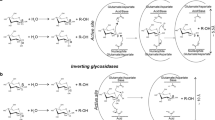Abstract.
Plants are exposed to a wide range of toxic and bioactive low-molecular-weight molecules from both exogenous and endogenous sources. Glycosylation is one of the primary sedative mechanisms that plants utilise in order to maintain metabolic homeostasis. Recently, a range of glycosyltransferases has been characterized in detail with regard to substrate specificity. The next step in increasing our understanding of the biology of glycosylation will require information regarding the exact role of individual glycosyltransferases in planta, as well as an insight into their potential involvement in metabolon-complexes. Hopefully, this will answer how a large number of glycosyltransferases with broad, rather than narrow, substrate specificity can be constrained in order to avoid interfering with other pathways of primary and secondary metabolism. These and other topics are discussed.
Similar content being viewed by others
Author information
Authors and Affiliations
Additional information
Electronic Publication
Rights and permissions
About this article
Cite this article
Jones, P., Vogt, T. Glycosyltransferases in secondary plant metabolism: tranquilizers and stimulant controllers. Planta 213, 164–174 (2001). https://doi.org/10.1007/s004250000492
Received:
Accepted:
Published:
Issue Date:
DOI: https://doi.org/10.1007/s004250000492




